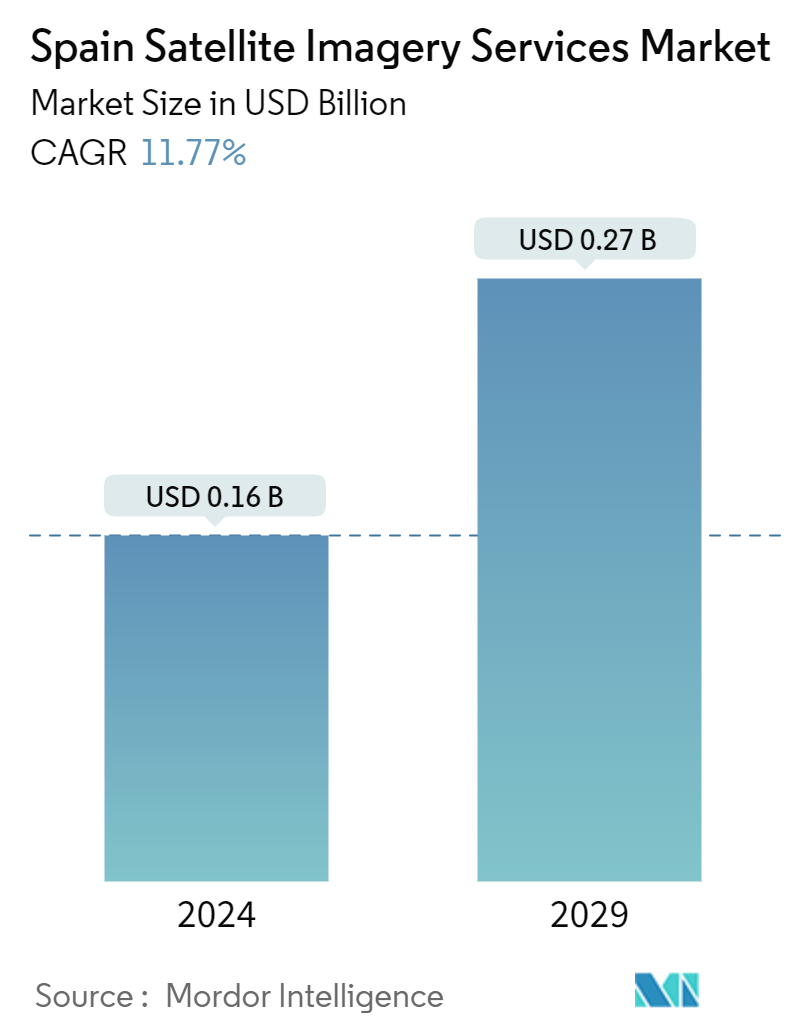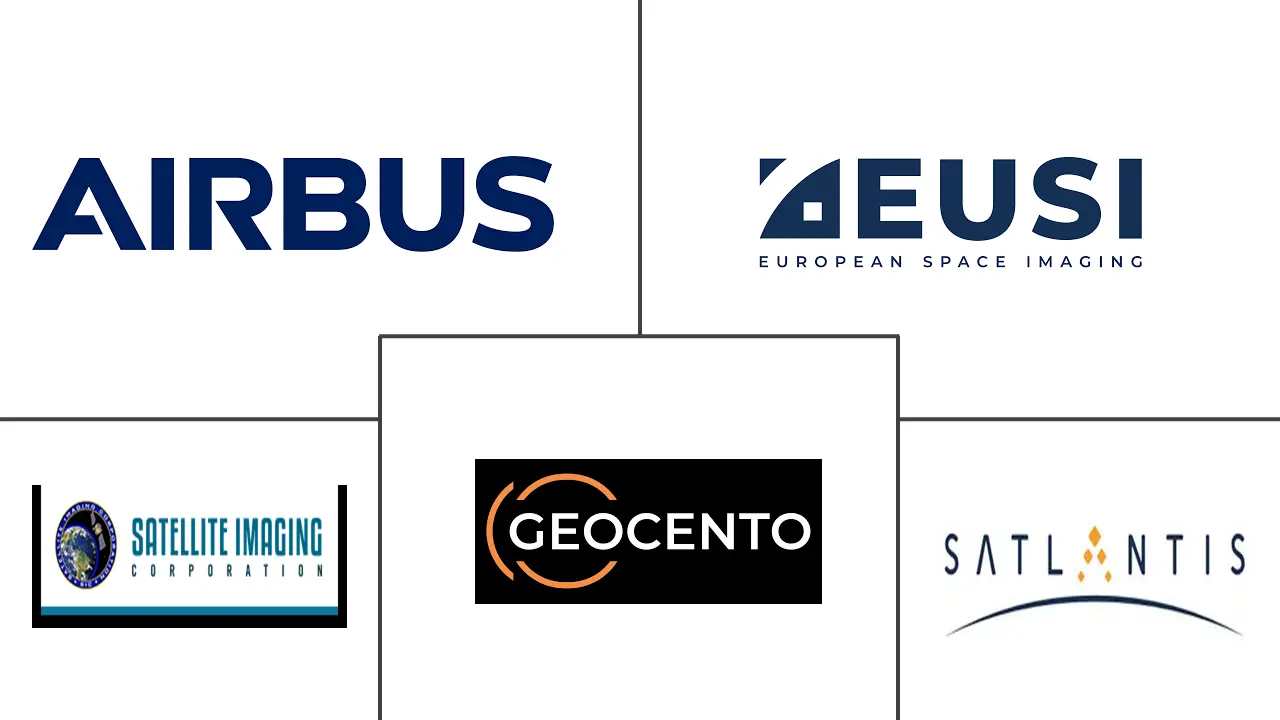Market Size of Spain Satellite Imagery Services Industry

| Study Period | 2019 - 2029 |
| Base Year For Estimation | 2023 |
| Market Size (2024) | USD 0.16 Billion |
| Market Size (2029) | USD 0.27 Billion |
| CAGR (2024 - 2029) | 11.77 % |
| Market Concentration | Medium |
Major Players
*Disclaimer: Major Players sorted in no particular order |
Spain Satellite Imagery Services Market Analysis
The Spain Satellite Imagery Services Market size is estimated at USD 0.16 billion in 2024, and is expected to reach USD 0.27 billion by 2029, growing at a CAGR of 11.77% during the forecast period (2024-2029).
Growing concerns about climate change, environmental degradation, and disaster monitoring are driving up demand for satellite imagery services in the country. Furthermore, governments raise their defense budgets as security concerns and geopolitical conflicts between countries develop. They're using commercial satellite photography to give data that will assist them in improving defense and security operations. Satellite imaging also offers information on the planet's chemical, physical, and biological aspects.
- The advent of autonomous cars led to advancements in image maps, which may soon transform into HD maps with extreme accuracy (ideally below 10 cm). Thus, companies that provide mapping services and products invest in developing these HD maps. With the rollout of these maps, the application of commercial satellite imaging is likely to be expanded to the transportation industry.
- Furthermore, the proliferation of new mobile geospatial sensor platforms, coupled with the rapid miniaturization of technologies, led to the development of small satellites (smallsats), which can be easily designed and deployed. Technological advancements in space 3D printing, electronic components miniaturization, advanced material technology, artificial intelligence (AI), and machine learning will likely assist manufacturers in space.
- Remotely sensed satellite images and data include spatial and temporal resolutions. Spectral statistics involve elements of remotely sensed image classification. The temporal resolution allows for generating land cover maps (for environmental planning, land use change detection, and transportation planning) and data integration and analysis of urban areas using medium-resolution remote sensing imagery.
- This mode mainly focuses on the documentation of built-up areas and is used to differentiate between residential, commercial, and industrial zones. Moreover, location-based services are extensively used in emergency and disaster management, as coordinating emergency management procedures with location-awareness activities is paramount.
- The players in the market are developing new solutions to expand their market share. For instance, in September 2022, ICeye, the Finnish owner of the world's largest synthetic-aperture radar (SAR) satellite constellation, teamed up to develop and build a new generation of satellites that combine radar and optical imaging in Spain. It is operating with Satlantis to manufacture four satellites for a new constellation in low earth orbit called Tandem for Earth Observation (Tandem4EO). This will consist of two radar and two VHR optical satellites with a resolution of under 1m.
- The aerial and terrestrial imaging solutions pose a significant challenge to the growth of the market studied, as they provide better resolution than satellite imaging. In addition, the inability of satellites to work in adverse weather conditions, such as fog, snow, and cloud cover, also restricts the market growth. Aerial imaging can be carried out under cloud cover, with minor corrections to be applied during post-processing. This guarantees cloud-free data delivery. Due to low altitude acquisition, aerial data does not suffer from atmospheric effects, which can impact the quality of the data in satellite imagery.
Spain Satellite Imagery Services Industry Segmentation
Satellite imagery refers to images of the Earth taken from satellites orbiting the planet. These satellites are equipped with various sensors for detecting visible light, infrared light, microwave radiation, and more to craft high-resolution images. These images combine to create visual representations of the Earth that provide new perspectives on climate, geography, and manmade structures.
The Spain satellite imagery services market is segmented by application (geospatial data acquisition and mapping, natural resource management, surveillance, and security, conservation, and research, disaster management, intelligence), by end-user (government, construction, transportation, and logistics, military and defense, forestry, and agriculture).
The market sizes and forecasts are provided in terms of value (USD) for all the above segments.
| By Application | |
| Geospatial Data Acquisition and Mapping | |
| Natural Resource Management | |
| Surveillance and Security | |
| Conservation and Research | |
| Disaster Management | |
| Intelligence |
| By End-User | |
| Government | |
| Construction | |
| Transportation and Logistics | |
| Military and Defense | |
| Forestry and Agriculture | |
| Others |
Spain Satellite Imagery Services Market Size Summary
The Spain Satellite Imagery Services market is experiencing significant growth, driven by increasing concerns over climate change, environmental degradation, and the need for disaster monitoring. The market is also bolstered by heightened defense budgets and security concerns, prompting governments to leverage commercial satellite photography for enhanced defense and security operations. Technological advancements, such as the development of small satellites and the integration of artificial intelligence and machine learning, are further propelling the market. These innovations enable more accurate and detailed satellite imagery, which is increasingly being used across various sectors, including transportation, logistics, and urban planning. The market is moderately consolidated, with key players investing in strategic partnerships and product developments to expand their market share.
The transportation and logistics sectors are among the early adopters of satellite imagery, utilizing it for monitoring and planning purposes. The rise of e-commerce and cross-border logistics has amplified the demand for satellite imaging to optimize route planning and ensure efficient supply chain management. Additionally, satellite imagery is being integrated into security and law enforcement applications, aiding in crime mapping and hotspot detection. Despite challenges posed by aerial imaging solutions and adverse weather conditions affecting satellite performance, the market continues to expand. The democratization of space technology has made satellite imagery more accessible, fostering innovation and the emergence of new applications across diverse economic sectors.
Spain Satellite Imagery Services Market Size - Table of Contents
-
1. MARKET INSIGHTS
-
1.1 Market Overview
-
1.2 Industry Attractiveness - Porter's Five Forces Analysis
-
1.2.1 Bargaining Power of Buyers
-
1.2.2 Bargaining Power of Suppliers
-
1.2.3 Threat of New Entrants
-
1.2.4 Threat of Substitutes
-
1.2.5 Intensity of Competitive Rivalry
-
-
1.3 Industry Value Chain Analysis
-
1.4 Assessment of the Impact of COVID-19 on the Market
-
-
2. MARKET SEGMENTATION
-
2.1 By Application
-
2.1.1 Geospatial Data Acquisition and Mapping
-
2.1.2 Natural Resource Management
-
2.1.3 Surveillance and Security
-
2.1.4 Conservation and Research
-
2.1.5 Disaster Management
-
2.1.6 Intelligence
-
-
2.2 By End-User
-
2.2.1 Government
-
2.2.2 Construction
-
2.2.3 Transportation and Logistics
-
2.2.4 Military and Defense
-
2.2.5 Forestry and Agriculture
-
2.2.6 Others
-
-
Spain Satellite Imagery Services Market Size FAQs
How big is the Spain Satellite Imagery Services Market?
The Spain Satellite Imagery Services Market size is expected to reach USD 0.16 billion in 2024 and grow at a CAGR of 11.77% to reach USD 0.27 billion by 2029.
What is the current Spain Satellite Imagery Services Market size?
In 2024, the Spain Satellite Imagery Services Market size is expected to reach USD 0.16 billion.

